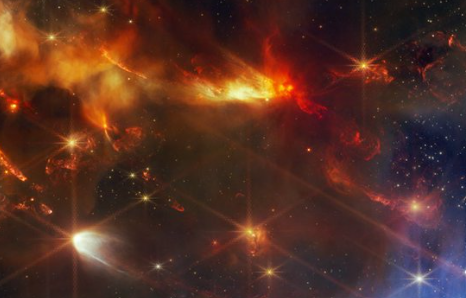The event left many all over the world stunned. The whole process of star formation are more orderly and coordinated than previously understood. A religious friend had to chime in with it is all happening by the hand of God.
For the first time, astronomers using the James Webb Space Telescope (JWST) have captured a stunning and peculiar celestial event: a cluster of newborn stars ejecting high-speed gas jets in a synchronized manner, all aligned in the same direction. This remarkable observation, detailed in a recent publication in the Astrophysical Journal, sheds light on the early stages of stellar formation and introduces new questions about the uniformity of these protostellar outflows.
NASA’s James Webb Space Telescope has captured a stunning image of the Serpens Nebula, revealing aligned proto-stellar outflows.
These jets of gas, spewing from newborn stars, are all slanted in the same direction providing groundbreaking insights into star formation. pic.twitter.com/qJPWcUYAv4
— Pieter Nierop – $enginedriver $cardano-express (@nierop_pieter) June 20, 2024
The discovery was made in the Serpens Main nebula, a sprawling cloud of star-forming gas located in the Serpens constellation, about 1,300 light-years away from Earth. The nebula is being studied with JWST’s Near-Infrared Camera (NIRCam), which captures the intricate details of these young stars and their dynamic behaviors. The NIRCam observations revealed at least 20 infant stars actively releasing jets of gas that collide with and energize the surrounding molecular cloud material.
Of particular interest is a subset of 12 stars, whose jets are almost perfectly aligned, resembling “sleet pouring down during a storm.” This uniformity is highly unusual and suggests that these stars may have formed simultaneously along the same dense gas filament, influenced by a strong magnetic field that directs the jets’ trajectories. This alignment offers a rare glimpse into the physical processes that govern star formation and the role of magnetic fields in shaping the cosmos.
Iconic Crab Nebula shines in gorgeous James Webb Space Telescope views (video, image) https://t.co/DXumANaV1W
— HK (@HKgolfgoon) June 21, 2024
The principal investigator, Klaus Pontoppidan from NASA’s Jet Propulsion Laboratory, highlighted the significance of this finding, stating that while astronomers have long assumed that stars forming from collapsing clouds would spin in similar directions, this phenomenon has never been directly observed until now. The aligned jets serve as a historical record of how stars are born, providing a visual testament to the theoretical models of star formation.
This alignment is also puzzling because such a pattern is unlikely to occur by chance and suggests a more complex interplay of forces at the early stages of star formation. The researchers propose that a powerful magnetic field along the star-forming filament is crucial not only for directing the jets but also for potentially influencing the initial conditions under which these stars were born.
A new image of Serpens from the James Webb Space Telescope shows an intriguing group of aligned protostellar outflows within one region of the nebula. The discovery of these aligned objects is providing information into the fundamentals of how stars are born.
Credit- Nasa pic.twitter.com/v7PcO0573M— Zain Kapadi (@KapadiZain) June 22, 2024
To further unravel this mystery, the team plans to use JWST’s Near-Infrared Spectrograph (NIRSpec) to analyze the chemical composition of the Serpens Main nebula. This next phase of research could offer insights into how elements are transferred from stars to forming planets, potentially providing clues about the development of solar systems like our own.
Key Points:
i. Astronomers using the James Webb Space Telescope (JWST) have observed a group of newborn stars in the Serpens Main nebula, about 1,300 light-years away, ejecting high-speed gas jets that are unusually aligned in the same direction.
ii. This phenomenon, called protostellar outflows, involves jets of gas released by baby stars that impact and energize the surrounding molecular cloud material.
iii. The alignment of the jets from at least 20 observed stars, particularly a group of 12, suggests a coordinated formation along the same dense gas filament, possibly guided by a strong magnetic field.
iv. The observation provides the first direct evidence supporting the theory that stars formed from collapsing clouds might spin in the same direction, a hypothesis previously unconfirmed.
v. Future studies with JWST’s Near-Infrared Spectrograph (NIRSpec) will further investigate the chemical composition of the nebula, offering insights into the processes that transfer elements from stars to forming planets.
Peter J Grien – Reprinted with permission of Whatfinger News



